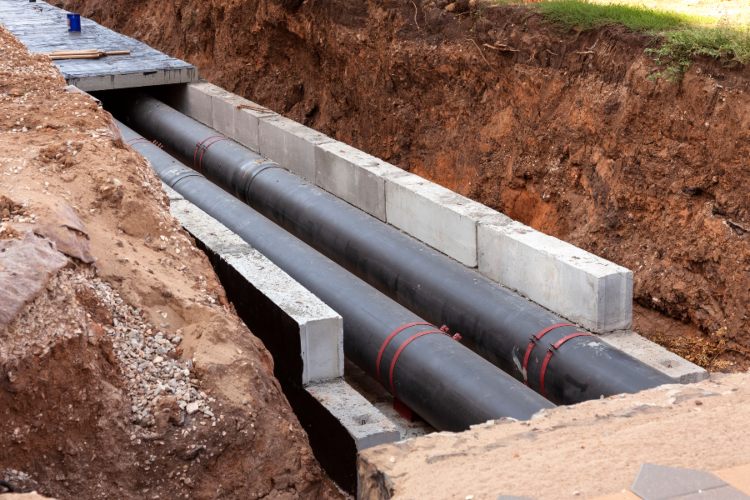How Far Below the Surface Must a Water Line Be Buried?
When installing or repairing water lines, one question often comes up: How deep should they be buried? Proper burial depth prevents freeze damage and ensures that your water line stays operational throughout the year.

The Importance of Water Line Burial Depth
The correct burial depth for a water line is important for several reasons. Water lines that are too shallow are vulnerable to freezing in cold temperatures and may suffer from damage due to the weight of the earth above them or from landscaping activities. On the other hand, burying a water line too deep can lead to higher installation and repair costs without necessarily offering extra benefits. By finding the optimal depth, you can:
- Prevent Freezing: When water inside a pipe freezes, it expands, potentially causing the pipe to burst. Buried deep enough, pipes are protected from freezing temperatures.
- Reduce Accidental Damage: Water lines buried at the right depth are less likely to be damaged by common yard maintenance, construction, or landscaping activities.
- Maintain Water Flow: Pipes that freeze or crack can cause disruptions in water service. Correct burial depth keeps water flowing consistently.
Proper depth ensures your water line is protected year-round, preventing costly repairs and maintaining the flow of water to your home or business.
How Frost Depth Impacts Water Line Burial
One of the most important factors when determining the water line burial depth is frost depth. Frost depth refers to how deeply the ground freezes during the winter months, and it varies based on climate and soil type. In South Kansas City, the frost depth typically reaches about 36 inches, though unusually cold winters can cause it to go even deeper. Frost depth is significant because water lines installed above the frost line are at risk of freezing and bursting during cold spells. Water lines should be buried six to twelve inches below the frost line to provide an added layer of security against unexpected cold snaps. For South Kansas City residents, this means burying water lines at least 42 inches deep. However, each property is unique, so it’s wise to consult a plumbing professional who can assess your specific conditions.
Factors That Influence Water Line Burial Depth
While frost depth is the most important consideration, several other factors should be considered when determining how deep to bury a water line. Some of the key considerations include:
- Local Regulations: Building codes vary by municipality, and South Kansas City may have specific regulations governing the minimum and maximum burial depth for water lines. Local codes ensure consistency and safety, so be sure to follow them closely. Kevin Ginnings Plumbing makes sure your work is compliant.
- Soil Composition: Soil density plays a significant role in how well the ground insulates water lines. Dense, clay-like soils retain heat better and may not require as deep a burial as sandy or rocky soils, which allow more rapid temperature fluctuations. Kansas City’s varied soil types make it important to assess the soil composition before deciding on a burial depth.
- Water Line Materials: Different pipe materials have varying degrees of durability and tolerance to temperature changes. Materials like copper and PEX are popular due to their strength and resistance to freezing, while some types of PVC may require deeper burial to prevent freezing.
- Weight and Surface Load: If you plan to install a water line under a driveway, parking area, or other locations that bear heavy loads, you may need to bury the line deeper to prevent it from cracking under pressure. The added depth will protect it from the additional weight and stress.
- Potential for Future Landscaping: Anticipating any future landscaping projects can also influence burial depth. If you foresee digging in certain areas, it’s wise to either mark water line locations carefully or opt for deeper burial to reduce accidental interference.
Finding and Repairing Water Lines
Locating an existing water line for maintenance or repair can be tricky, especially if you’re unsure of its depth or placement. At Kevin Ginnings, we use specialized equipment to detect buried water lines without unnecessary digging. This technology allows us to accurately locate water lines using tools like ground-penetrating radar and tracer wires, our team can pinpoint the exact location of water lines, minimizing disruption to your yard or property. Once located, we can identify the issue and offer a targeted repair solution. Trying to locate or dig up your own water line can lead to damage and potential injuries, especially if the line is pressurized. We make sure the job is done safely and accurately.
Key Insights to Remember
Before embarking on any water line installation or repair, here are some takeaways to remember:
- Frost Depth Matters: The local frost depth (around 36 inches for South Kansas City) determines how deep to bury water lines.
- Comply with Local Codes: Local regulations set minimum burial depths, ensuring water lines remain safe from freezing and accidental damage.
- Assess Environmental Factors: Soil type, pipe materials, and surface loads all impact the ideal burial depth for your water line.
- Hire a Professional: Accurate installation requires the right tools and expertise. Kevin Ginnings Plumbing will ensure your water lines are installed correctly and according to code.
Contact Kevin Ginnings Plumbing
Whether you’re installing a new water line, conducting repairs, or simply curious about water line burial depth, the team at Kevin Ginnings Plumbing has you covered. As South Kansas City’s trusted plumbing service provider, we bring years of experience, local knowledge, and industry expertise to every job. We can evaluate your property’s needs, ensure compliance with local codes, and deliver solutions to keep your water lines secure and functional. Contact us today for a free estimate.
